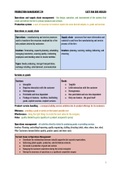PRODUCTION MANAGEMENT 214 LUCY VAN DER MEULEN
Operations and supply chain management - the design, operation, and improvement of the systems that
create and deliver the firm’s primary products and services
Production system - a user of resources to transform inputs into some desired outputs, ie. goods and services
Operations vs supply chain
Operations - manufacturing and service processes Supply chain - processes that move information and
used to transform the resources employed by a firm material to and from the manufacturing and service
into products desired by customers process of the firm
Involves: Forecasting, capacity planning, scheduling, Involves: planning, sourcing, making, delivering, and
managing inventories, assuring quality, motivating returning
employees and deciding where to locate facilities
Types: Goods producing, storage/transportation,
exchange retailing, entertainment, communication
Services vs goods
Services Goods
● Intangible ● Tangible
● Requires interaction with the customer ● Little interaction with the customer
● Heterogeneous ● Homogeneous
● Perishable and time dependent ● Non-perishable and non-time dependent
● Package of features - facilities, facilitating ● Only one feature - the good itself
goods, explicit services, implicit services
Product–service bundling - a company building service activities into its product offerings for its customers
Efficiency - providing a good or service at the lowest possible cost
Effectiveness - doing the right things to create the most value for the company
Value - quality divided by price (quality of a product compared to price)
Operations management - all activities directly related to producing goods or providing services
Involves: Planning, controlling/improving, quality organising, staffing, directing (what, when, where, how, who)
Why: Customers demand better quality, greater speed, and lower costs
Current Issues in Operations Management:
● Coordinate the relationships between mutually supportive but separate organisations.
● Optimising global supplier, production, and distribution networks.
● Increased co-production of goods and services
● Managing the customers experience during the service encounter
● Raising the awareness of operations as a significant competitive weapon
1
, Management efficiency ratios
● Net income per employee
● Revenue (or sales) per employee
𝑎𝑛𝑛𝑢𝑎𝑙 𝑐𝑟𝑒𝑑𝑖𝑡 𝑠𝑎𝑙𝑒𝑠
● 𝑅𝑒𝑐𝑒𝑖𝑣𝑎𝑏𝑙𝑒 𝑇𝑢𝑟𝑛𝑜𝑣𝑒𝑟 = 𝑎𝑣𝑒𝑟𝑎𝑔𝑒 𝑎𝑐𝑐𝑜𝑢𝑛𝑡𝑠 𝑟𝑒𝑐𝑒𝑖𝑣𝑎𝑏𝑙𝑒
1
● 𝐷𝑎𝑦𝑠 𝑡𝑜 𝑔𝑒𝑡 𝑚𝑜𝑛𝑒𝑦 𝑏𝑎𝑐𝑘 𝑓𝑟𝑜𝑚 𝑑𝑒𝑏𝑡𝑜𝑟𝑠 = 𝑟𝑒𝑐𝑒𝑖𝑣𝑎𝑏𝑙𝑒 𝑡𝑢𝑟𝑛𝑜𝑣𝑒𝑟
* 360
𝑐𝑜𝑠𝑡 𝑜𝑓 𝑔𝑜𝑜𝑑𝑠 𝑠𝑜𝑙𝑑
● 𝐼𝑛𝑣𝑒𝑛𝑡𝑜𝑟𝑦 𝑇𝑢𝑟𝑛𝑜𝑣𝑒𝑟 = 𝑎𝑣𝑒𝑟𝑎𝑔𝑒 𝑖𝑛𝑣𝑒𝑛𝑡𝑜𝑟𝑦 𝑣𝑎𝑙𝑢𝑒
𝑟𝑒𝑣𝑒𝑛𝑢𝑒
● 𝐴𝑠𝑠𝑒𝑡 𝑇𝑢𝑟𝑛𝑜𝑣𝑒𝑟 = 𝑡𝑜𝑡𝑎𝑙 𝑎𝑠𝑠𝑒𝑡𝑠
𝑜𝑢𝑡𝑝𝑢𝑡
● 𝑃𝑟𝑜𝑑𝑢𝑐𝑡𝑖𝑣𝑖𝑡𝑦 = 𝑖𝑛𝑝𝑢𝑡
Operations and supply chain strategy - setting broad policies and plans for using the resources of a firm to
best support its long-term competitive strategy
Operations effectiveness - the core business processes needed to run a business
Shareholders - Individuals or companies that legally own one or more shares of stock in the company
Stakeholders - Individuals or organisations who are influenced, either directly or indirectly, by the actions of
the firm
Triple bottom line - A business strategy that includes social, economic, and environmental criteria
- Social: pertains to fair and beneficial business practices toward labour, the community, and the
region in which a firm conducts is business
- Economic: the firm’s obligation to compensate shareholders who provide capital via competitive
returns on investment
- Environmental: the firm’s impact on the environment
Competitive Dimensions
- Cost vs Price - make product/deliver services cheaply
- Quality vs Price - high quality, high cost or low quality, low cost
- Delivery speed - make and deliver product/service quickly
- Delivery reliability - meet estimated delivery time]
- Changes in demand - change production volume
- Flexibility and new product introduction - Changing offering
- Other product-specific criteria - support related businesses to augment product sales
2




